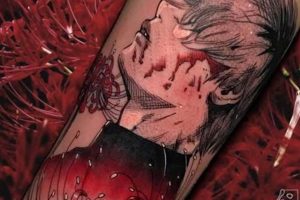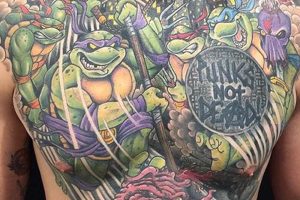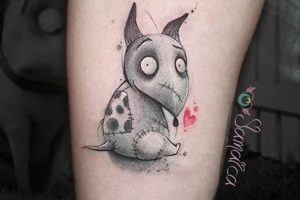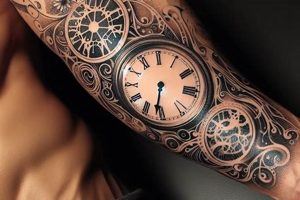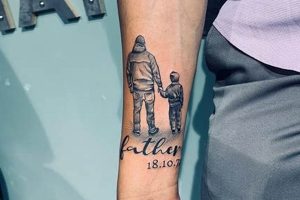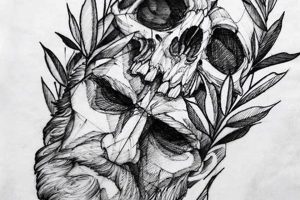Tattoos inspired by the horror genre encompass a wide range of imagery, drawing from classic monster movies, gothic literature, and psychological thrillers. These designs can feature anything from stylized depictions of iconic figures like Dracula or Frankenstein’s monster to more abstract representations of fear, dread, and the macabre, such as skulls, ravens, or eerie landscapes. Specific examples include portraits of horror icons, depictions of gruesome scenes, or symbolic representations of dark themes.
For enthusiasts, these permanent illustrations offer a powerful medium for self-expression, allowing individuals to showcase their appreciation for the genre and explore complex themes related to mortality, fear, and the darker aspects of human nature. The historical context of horror in art, dating back centuries, provides a rich tapestry from which to draw inspiration. From ancient folklore and mythology to the gothic novels of the 19th century and modern cinematic horror, the genre’s evolution offers diverse aesthetic possibilities for impactful and meaningful body art.
Exploration of specific subgenres within horror, analysis of popular imagery and their symbolic meanings, and practical advice regarding artist selection and tattoo placement will further illuminate the world of darkly expressive body art.
1. Genre
Genre serves as the foundational element for horror tattoos, dictating the thematic and aesthetic direction. The chosen genre influences the selection of imagery, color palettes, and overall style. A tattoo inspired by cosmic horror, for example, will likely feature otherworldly creatures and abstract designs in muted, dark tones, evoking a sense of existential dread. Conversely, a slasher film-inspired tattoo might depict a specific villain or iconic weapon in bold, graphic detail, emphasizing visceral horror and gore. Understanding the nuances of each genre is crucial for creating a cohesive and impactful tattoo.
Consider the difference between a tattoo inspired by Japanese horror (J-horror) and one rooted in gothic horror. J-horror often incorporates themes of psychological disturbance and unsettling supernatural phenomena, potentially leading to tattoos featuring vengeful spirits or eerie, distorted figures. Gothic horror, on the other hand, often draws on classic literary monsters and settings, resulting in tattoos featuring vampires, crumbling castles, or religious iconography imbued with dark undertones. The genre selection informs the narrative and visual language of the tattoo, ensuring its authenticity and resonance with the chosen theme.
Successful horror tattoos demonstrate a clear understanding of the chosen genre’s conventions and tropes. This knowledge ensures the tattoo effectively captures the desired atmosphere and resonates with other fans of the genre. Selecting the appropriate genre provides a framework for the entire design process, from initial concept to final execution. This focused approach results in a more impactful and meaningful piece of body art that genuinely reflects the individual’s appreciation for the specific corner of the horror landscape they choose to represent.
2. Imagery
Imagery forms the core visual language of horror tattoos, translating abstract fear and fascination into concrete artistic representations. Careful selection of imagery is crucial for conveying the intended emotional impact and thematic resonance. A snarling werewolf evokes primal fear and transformation, while a delicate spiderweb can suggest lurking danger and insidious evil. The effectiveness of the tattoo hinges on the chosen image’s ability to communicate a specific aspect of horror, whether it’s the grotesque, the macabre, or the psychologically disturbing. Consider the contrast between a realistic portrait of a classic monster like Dracula and a more abstract depiction of a decaying skull. The former relies on recognizable iconography, while the latter utilizes symbolism to evoke a broader sense of mortality and decay.
Real-life examples further illustrate the importance of imagery selection. A tattoo featuring the iconic mask of Michael Myers immediately conjures the slasher genre’s suspense and brutality. A depiction of Cthulhu, on the other hand, taps into the cosmic horror’s unsettling vastness and otherworldly dread. Even subtle details within the imagery can significantly alter the tattoo’s meaning. A raven with outstretched wings can symbolize impending doom, while a perched raven might represent introspection or observation of the macabre. Understanding the cultural and historical connotations associated with different images allows for more nuanced and impactful designs.
Successful horror tattoos leverage imagery to tell a story or evoke a specific emotion. They go beyond mere decoration, acting as visual narratives that resonate with the wearer and the viewer. The challenge lies in selecting imagery that effectively translates the individual’s fascination with horror into a powerful and aesthetically pleasing piece of art. This requires careful consideration of the genre, personal preferences, and the desired emotional impact. Ultimately, the chosen imagery becomes a permanent statement, reflecting the wearer’s unique relationship with the horror genre.
3. Placement
Placement significantly impacts the overall effectiveness of horror tattoos, influencing visibility, composition, and the interplay between the design and the body’s natural contours. Strategic placement can enhance the tattoo’s narrative, creating a more immersive and impactful experience. Consideration of body shape, visibility preferences, and the design’s size and complexity are crucial for maximizing the tattoo’s visual impact and thematic resonance.
- Visibility and Concealment
Visibility plays a crucial role in how a horror tattoo interacts with the viewer and the wearer. Highly visible placements, such as the hands or neck, maximize exposure and invite immediate engagement. These placements can be used for bold statements, showcasing a favorite character or iconic imagery. Conversely, concealed placements, like the back or thigh, offer a sense of intimacy and personal significance. A hidden horror tattoo can function as a private reminder of one’s affinity for the genre, revealed selectively and adding an element of surprise. The choice depends on the individual’s preference for public display versus personal expression.
- Body Contours and Composition
The human body’s natural curves and contours provide a dynamic canvas for horror tattoos. Skilled artists leverage these contours to enhance the design’s three-dimensionality and create a more integrated aesthetic. A sprawling creature design might wrap around the arm or leg, emphasizing its movement and form. A portrait might be strategically positioned to utilize the musculature underneath, adding depth and realism. Careful consideration of the body’s shape allows for a more harmonious and impactful composition.
- Size and Complexity of the Design
The size and complexity of the tattoo design also influence placement decisions. Large, intricate designs require ample space, often favoring areas like the back, chest, or thigh. Smaller, simpler designs offer greater flexibility, allowing for placement on areas like the wrist, ankle, or behind the ear. A large, detailed depiction of a demonic entity might overwhelm a smaller area like the forearm, while a small, symbolic skull can be effectively placed almost anywhere. Balancing the design’s scale with the available space ensures a visually balanced and aesthetically pleasing result.
- Narrative Enhancement through Placement
Strategic placement can enhance the narrative potential of horror tattoos. A spider crawling up the neck can evoke a sense of creeping dread, while a gaping maw placed on the shoulder could suggest a lurking predator. Placement can amplify the chosen imagery’s inherent symbolism, adding another layer of meaning to the tattoo. A strategically placed tattoo transforms the body into a storytelling medium, allowing for a deeper exploration of the chosen horror theme.
Ultimately, placement choices contribute significantly to the overall impact and meaning of horror tattoos. By carefully considering factors like visibility, body contours, design size, and narrative potential, individuals can ensure their tattoo effectively captures the essence of the chosen horror theme and becomes a powerful expression of personal style and appreciation for the genre.
4. Style
Style is the artistic lens through which horror tattoo ideas are realized, transforming concepts into visually compelling and thematically resonant designs. The chosen style dictates the overall aesthetic, influencing linework, color palettes, and the level of detail. Selecting a style congruent with the desired horror theme is crucial for achieving a cohesive and impactful result. The style acts as a visual language, conveying specific emotions and narratives within the horror genre.
- Realism
Realism prioritizes accurate and detailed depictions, striving to capture the subject matter with lifelike precision. In horror tattoos, realism can create intensely visceral and disturbing imagery. Imagine a hyperrealistic portrait of a decaying zombie or a meticulously rendered depiction of a gruesome wound. This style excels at conveying the grotesque and unsettling aspects of horror, making it a powerful choice for those seeking to capture the genre’s raw intensity. However, realism demands a high level of skill from the artist, and the intricate detail requires significant time and investment.
- Traditional
Traditional, or American Traditional, tattooing employs bold lines, vibrant colors, and iconic imagery. While often associated with simpler designs, traditional style can be effectively applied to horror themes. Think of a boldly outlined skull with stylized flames or a classic depiction of a dagger dripping with blood. This style lends itself well to symbolic representations of horror, creating visually striking and timeless designs. Its bold simplicity can also translate effectively to smaller tattoos, allowing for greater flexibility in placement.
- Neo-Traditional
Neo-Traditional builds upon the foundations of traditional tattooing, incorporating more detailed shading, a wider color palette, and more complex compositions. This style allows for greater nuance and narrative depth within horror tattoos. A neo-traditional design might depict a stylized portrait of a vampire with intricate background details or a dramatic scene from a classic horror film. This style offers a balance between bold aesthetics and detailed storytelling, allowing for a wider range of creative possibilities within the horror genre.
- Illustrative
Illustrative tattooing draws inspiration from various art forms, including comic books, graphic novels, and traditional illustration. This style often features bold outlines, dynamic compositions, and a focus on visual storytelling. Within horror, illustrative tattoos can range from stylized depictions of iconic monsters to complex scenes depicting nightmarish landscapes or surreal imagery. This style’s versatility allows for a wide range of interpretations, making it a popular choice for those seeking unique and expressive horror tattoos.
The chosen style significantly impacts the overall aesthetic and emotional impact of a horror tattoo. Selecting the appropriate style ensures that the design effectively communicates the desired horror theme, whether through the visceral realism of a decaying corpse or the stylized symbolism of a traditional skull. Understanding the strengths and limitations of each style allows individuals to make informed decisions, resulting in a tattoo that reflects both their personal aesthetic preferences and their unique relationship with the horror genre. Consideration of style, alongside other elements like imagery and placement, elevates a horror tattoo from a simple decoration to a powerful and evocative work of art.
5. Artist Skill
Artist skill is paramount in realizing effective horror tattoos, bridging the gap between concept and execution. The genre’s reliance on evocative imagery, often depicting complex creatures, intricate details, and nuanced expressions of fear or the macabre, necessitates a skilled hand. A technically proficient artist understands how to utilize line weight, shading, and color to create depth, texture, and atmosphere, transforming a two-dimensional design into a visceral, three-dimensional representation of horror. The artist’s ability to capture the essence of fear, dread, or the grotesque through skillful rendering significantly impacts the tattoo’s overall effectiveness and its ability to resonate with the viewer.
Consider the difference between a crudely drawn zombie and a meticulously rendered portrait of the undead. The former might elicit amusement or even indifference, while the latter, through skillful use of light and shadow, texture, and anatomical accuracy, can evoke genuine unease and fascination. Similarly, an amateurish attempt at a Lovecraftian creature might appear cartoonish or nonsensical, whereas a skilled artist can capture the otherworldly, unsettling nature of such entities through precise detail and a mastery of composition. Real-life examples abound in tattoo portfolios, showcasing the transformative power of skilled execution. A skilled artist can render a simple skull in a way that conveys not just mortality, but a specific emotion or narrative, such as despair, defiance, or even a macabre sense of humor.
Understanding the importance of artist skill empowers individuals seeking horror tattoos to make informed decisions. Researching artists specializing in the desired style and subject matter is crucial for achieving a successful outcome. Examining portfolios, seeking recommendations, and engaging in thorough consultations with potential artists allows individuals to gauge their technical proficiency and artistic vision. This careful selection process ensures the chosen artist possesses the necessary skills to translate complex horror concepts into impactful and lasting works of art. Ultimately, the artist’s skill determines whether a horror tattoo becomes a powerful expression of personal fascination or a regrettable misrepresentation of the genre’s rich and complex themes.
Tips for Effective Horror Tattoos
Achieving a truly impactful horror tattoo requires careful consideration of several factors. The following tips provide guidance for navigating the process, ensuring a result that effectively captures the desired horror aesthetic and thematic resonance.
Tip 1: Research Thoroughly
Thorough research is crucial. Explore different horror subgenres, imagery, and artistic styles. Gather reference images and consider their symbolic meanings within the horror genre. Understanding the historical and cultural context of chosen imagery can add depth and authenticity to the tattoo.
Tip 2: Choose a Skilled Artist
Artist skill is paramount. Seek artists specializing in the desired style, whether it’s realism, traditional, or illustrative. Examine portfolios and look for evidence of technical proficiency in rendering horror-themed imagery. A skilled artist can elevate a simple concept into a powerful and evocative piece of art.
Tip 3: Consider Placement Carefully
Placement impacts visibility, composition, and the overall effect. Think about how the design interacts with the body’s natural contours. Large, intricate designs require ample space, while smaller designs offer greater flexibility. Placement can also enhance the narrative, adding a layer of meaning to the imagery.
Tip 4: Collaborate with Your Artist
Open communication with the chosen artist is essential. Discuss ideas, share reference images, and be receptive to their professional input. A collaborative approach ensures the final design aligns with the individual’s vision while benefiting from the artist’s expertise.
Tip 5: Plan for Long-Term Care
Tattoos are a lifelong commitment. Plan for proper aftercare to maintain the tattoo’s vibrancy and prevent fading or infection. Follow the artist’s instructions diligently and protect the tattoo from excessive sun exposure. Proper care ensures the horror tattoo remains a source of pride and fascination for years to come.
Tip 6: Embrace the Symbolic
Horror often relies on symbolism to convey complex themes. Consider incorporating symbolic elements into the design, such as skulls, ravens, or religious iconography. Symbolic imagery can add depth and meaning to the tattoo, allowing for a more nuanced exploration of the horror genre.
Tip 7: Balance Detail and Simplicity
Intricate detail can enhance realism and create a visually stunning tattoo. However, excessive detail can sometimes make a design appear cluttered or overwhelming, especially in smaller tattoos. Strive for a balance between detail and simplicity, ensuring the design remains visually appealing and effectively communicates the desired horror theme.
By following these tips, individuals can navigate the process of acquiring a horror tattoo with confidence and ensure a result that effectively captures their fascination with the genre. A well-executed horror tattoo becomes more than just body art; it transforms into a powerful statement of personal expression and a lasting tribute to the captivating world of horror.
These guidelines provide a framework for achieving impactful and meaningful horror tattoos, ensuring that the final result resonates with both the wearer and those who appreciate the artistry and expressive potential of the genre.
Frequently Asked Questions about Horror Tattoos
This section addresses common queries regarding tattoos inspired by the horror genre, providing clarity and guidance for those considering such body art.
Question 1: How does one select appropriate imagery for a horror tattoo?
Image selection hinges on personal resonance with specific horror subgenres and their associated symbolism. Careful consideration of existing horror literature, film, and art helps identify impactful and meaningful imagery, ranging from iconic monsters to abstract representations of fear and dread. Consulting with experienced tattoo artists specializing in the genre further refines the selection process.
Question 2: What factors influence the longevity of a horror tattoo?
Longevity depends on several factors, including ink quality, artist skill, placement on the body, and aftercare practices. High-quality inks, applied by experienced artists, tend to retain vibrancy longer. Areas exposed to less sunlight and friction typically experience less fading. Consistent adherence to recommended aftercare procedures is crucial for preserving the tattoo’s integrity over time.
Question 3: Are certain horror tattoo styles more challenging to execute than others?
Realism and intricate detail-oriented styles, such as portraiture or biomechanical horror, generally require greater technical skill and experience on the artist’s part. These styles necessitate precise linework, shading, and color blending to achieve the desired effect. Simpler styles, like traditional or illustrative, while still demanding artistic talent, may offer more flexibility for artists with varying levels of experience.
Question 4: Can horror tattoos be effectively incorporated into existing tattoo designs?
Successful integration with existing tattoos requires careful planning and consideration of overall composition, thematic coherence, and stylistic consistency. Consulting with a skilled artist helps ensure the new horror elements complement rather than clash with existing artwork, creating a cohesive and visually balanced piece.
Question 5: What are common misconceptions regarding horror-themed tattoos?
One common misconception associates horror tattoos exclusively with darkness or negativity. However, these designs can represent various emotions and concepts, including resilience, overcoming fear, or celebrating the macabre. Another misconception involves the perceived limitations of the genre; horror offers diverse aesthetic possibilities, from intricate realism to stylized minimalism, catering to a wide range of individual preferences.
Question 6: How should one approach the selection of a tattoo artist for a horror-themed piece?
Selecting an artist requires thorough research and consideration of their portfolio, specializing in the desired style and demonstrating proficiency in horror-themed work. Recommendations from other enthusiasts, consultations with potential artists, and a review of their hygiene practices and studio reputation contribute to informed decision-making.
Careful consideration of these frequently asked questions ensures individuals embark on the journey of acquiring a horror tattoo with a comprehensive understanding of the process and the potential outcomes. This informed approach paves the way for a positive experience and a lasting piece of body art that reflects personal style and appreciation for the horror genre.
Further exploration of specific horror subgenres and their artistic interpretations can provide additional inspiration for those seeking to express their fascination with horror through the powerful medium of body art.
Horror Tattoo Ideas
Exploration of permanent horror-themed body modifications reveals a complex interplay of genre, imagery, placement, style, and artistic skill. Effective designs demonstrate a deep understanding of these elements, resulting in powerful visual narratives that resonate with the wearer and viewer. From the visceral realism of a decaying zombie to the stylized symbolism of a traditional skull, these tattoos offer a unique canvas for expressing personal fascination with the darker aspects of human imagination.
The enduring appeal of horror-themed body art lies in its ability to translate abstract fear and fascination into tangible, deeply personal forms of expression. Careful consideration of the discussed elements empowers individuals to make informed decisions, ensuring their chosen design becomes a meaningful and aesthetically impactful reflection of their unique relationship with the horror genre. This exploration underscores the importance of thoughtful planning and collaboration with skilled artists to achieve a truly resonant and lasting piece of body art.


